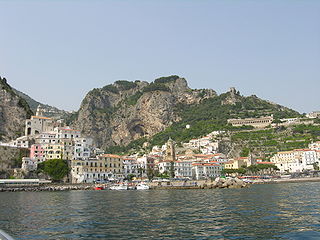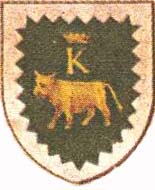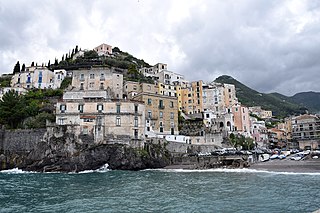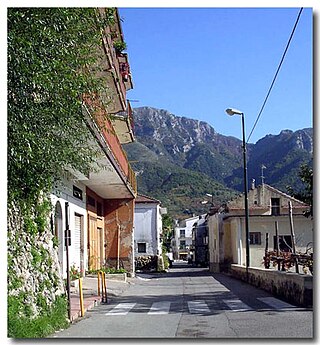
Amalfi is a town and comune in the province of Salerno, in the region of Campania, Italy, on the Gulf of Salerno. It lies at the mouth of a deep ravine, at the foot of Monte Cerreto, surrounded by dramatic cliffs and coastal scenery. The town of Amalfi was the capital of the maritime republic known as the Duchy of Amalfi, an important trading power in the Mediterranean between 839 and around 1200.

Sorrento is a town overlooking the Bay of Naples in Southern Italy. A popular tourist destination, Sorrento is located on the Sorrentine Peninsula at the south-eastern terminus of the Circumvesuviana rail line, within easy access from Naples and Pompei. The town is widely known for its small ceramics, lacework and marquetry (woodwork) shops.

Cava de' Tirreni is a city and comune in the region of Campania, Italy, in the province of Salerno, 10 kilometres northwest of the town of Salerno. It lies in a richly cultivated valley surrounded by wooded hills, and is a popular tourist resort. The abbey of La Trinità della Cava is located there.

Maiori is a town and comune on the Amalfi coast in the province of Salerno. It has been a popular tourist resort since Roman times, with the longest unbroken stretch of beach on the Amalfi coastline.

The House of Bove is an ancient noble patrician family of Ravello, Maritime Republic of Amalfi that held royal appointments in the Kingdom of Naples, and presided over feudal territories. After the dissolution of noble seats of the Kingdom of Naples in 1800 they were ascribed in the Libro d'Oro of Ravello. The Bove coat of arms is prominently displayed in the Duomo of Ravello.

The Duchy of Amalfi or the Republic of Amalfi was a de facto independent state centered on the Southern Italian city of Amalfi during the 10th and 11th centuries. The city and its territory were originally part of the larger ducatus Neapolitanus, governed by a patrician, but it extracted itself from Byzantine vassalage and first elected a duke in 958.

The Duchy of Naples began as a Byzantine province that was constituted in the seventh century, in the reduced coastal lands that the Lombards had not conquered during their invasion of Italy in the sixth century. It was governed by a military commander (dux), and rapidly became a de facto independent state, lasting more than five centuries during the Early and High Middle Ages. Naples remains a significant metropolitan city in present-day Italy.

The Ravello Festival is also popularly known as the "Wagner Festival" and is an annual summer festival of music and the arts held in the town of Ravello on the Amalfi coast in the Campania region of Italy. The festival has been held yearly since 1953 when the town fathers decided to use the historical fact of the visit to Ravello in 1880 by German composer Richard Wagner as a way to promote tourism and bolster the economy of the area in the difficult years following the Second World War. The composer had been so taken with the beauty of the Villa Rufolo in Ravello that he is said to have proclaimed, in reference to a character in his own opera Parsifal, "Here is the enchanted garden of Klingsor."

As one moves away from Naples in almost any direction, there is prominent musical activity to be found. These include, for example, the restoration and use of a number of the so-called "Vesuvian villas" in and near Ercolano, a string of once luxurious villas built in the 18th century and severely damaged by aerial bombardment in World War II. The most prominent of these is the Villa Campolieto, already restored, open and the site of chamber concerts by the Alessandro Scarlatti association.

Atrani is a city and comune on the Amalfi Coast in the province of Salerno in the Campania region of south-western Italy. It is located to the east of Amalfi, several minutes drive down the coast.

Minori is a comune in the province of Salerno, in the Campania region of south-western Italy. As a part of the Amalfi Coast, it was declared a UNESCO World Heritage Site in 1997.

Tramonti is a town and comune in the province of Salerno in the Campania region of south-western Italy. It is located in the territory of the Amalfi Coast.

Scala is a town and comune in the province of Salerno in the Campania region of south-western Italy. It is located on a rocky hill c. 400 m above sea-level and is part of the Amalfi Coast.

The Archdiocese of Amalfi-Cava de' Tirreni is an archdiocese of the Latin Church of the Catholic Church, with its episcopal see at Amalfi, not far from Naples. It was named Archdiocese of Amalfi until parts of the Diocese of Cava e Sarno were merged with it on September 30, 1986.

Villa Cimbrone is a historic villa in Ravello, on the Amalfi Coast of southern Italy. Dating from at least the 11th century, it is famous for its scenic belvedere, the Terrazza dell'Infinito.
Belmond Hotel Caruso is a hotel located in the hill town of Ravello, near Amalfi in southern Italy.

The Chiesa di San Giovanni del Toro is a church in Ravello, southern Italy.

Villa Rufolo is a villa within the historic center of Ravello, a town in the province of Salerno, southern Italy, which overlooks the front of the cathedral square. The initial layout dates from the 13th century, with extensive remodeling in the 19th century.

La Rondinaia is a villa in Ravello on the Amalfi Coast in southern Italy.

The d'Afflitto family is an ancient princely family originally from Amalfi, documented since the IX century, and spread throughout southern Italy.


























